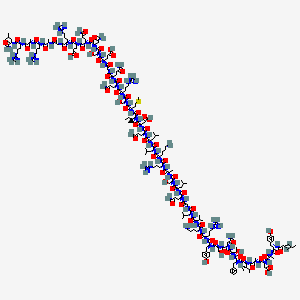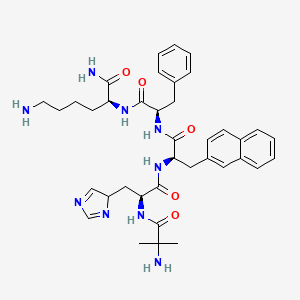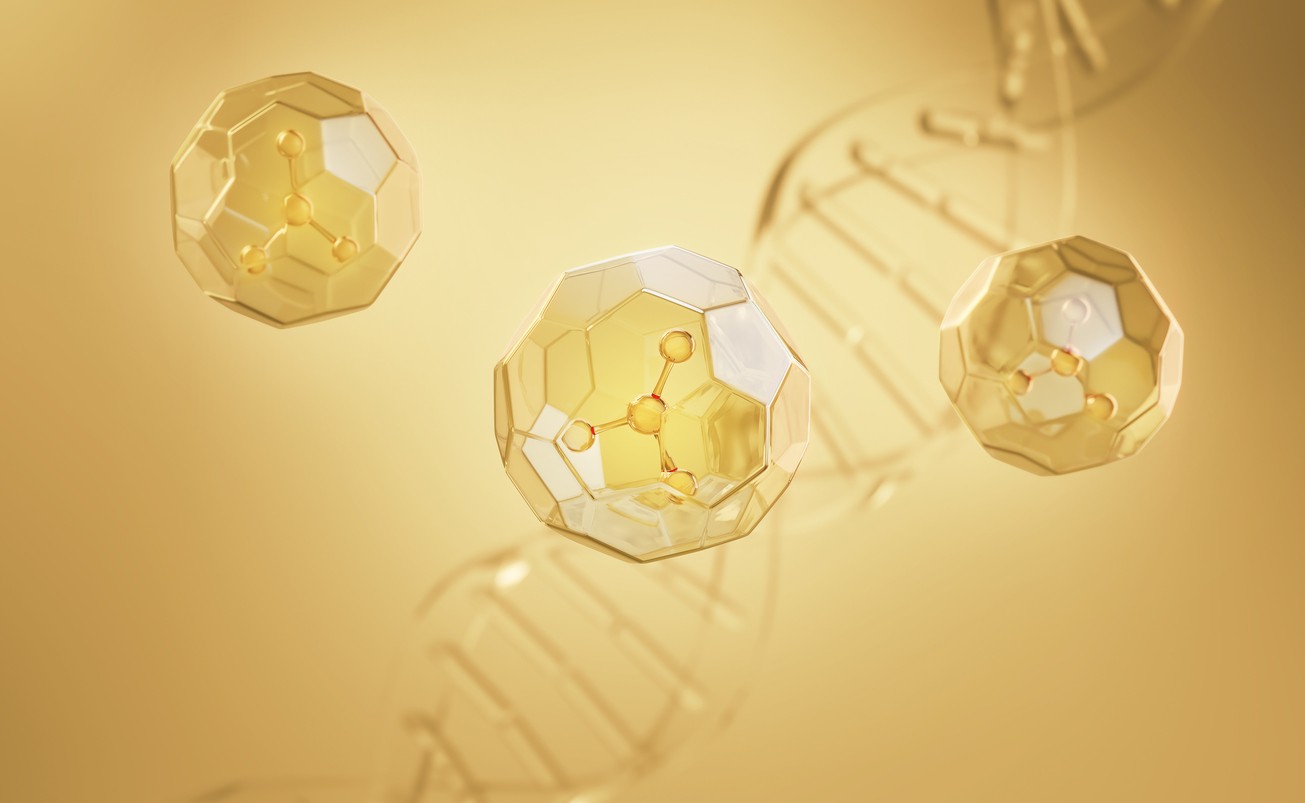Tesamorelin is a synthetic peptide that achieves this GHRH-R activation by mimicking the structure and actions of the native growth hormone-releasing hormone. Tesamorelin has the same 44 amino acid structure as the hormone and is modified with a trans-3-hexenoic acid at the N-terminus, as well as with an amino group + acetic acid at the C-terminus. According to Ferdinandi et al., this modification might support the peptide’s affinity for GHRH receptors and support its resistance to degradation, thus prolonging its activation of the receptors.(1) Additionally, research by González-Sales et al. indicates that after Tesamorelin exposure, somatotroph cells in the pituitary generally begin increasing GH production within 30-60 minutes.(2)
On the other hand, Ipamorelin is a synthetic peptide that appears to interact with the GHS-Rs, which are also receptors for the native hormone ghrelin, with the latter also referred to as the hunger hormone. Researchers such as Johansen suggest that by mimicking this hormone, Ipamorelin may induce the release of growth hormone by anterior pituitary cells but also potentially mediate other actions similar to ghrelin.(3)

Figure 1: Tesamorelin Chemical Structure

Figure 2: Ipamorelin Chemical structure
Latest Researches
Tesamorelin & Ipamorelin and Pituitary Cell Receptors
As a GHRH analog, Tesamorelin is thought to interact with pituitary gland cells by binding to GHRH-Rs on their surface, initiating a cascade of molecular events. According to Spooner et al. and Zhou et al., this binding induces structural changes in the GHRH receptors, notably a significant conformational shift involving transmembrane helix 6 (TM6), which exposes the intracellular side for G protein coupling.(4)(5) As a result, the enzyme adenylate cyclase may be activated, converting ATP (adenosine triphosphate) into cAMP (cyclic adenosine monophosphate). The elevated cAMP levels activate protein kinase A (PKA), leading to protein phosphorylation and amplification of GHRH receptor signaling initiated by Tesamorelin, ultimately stimulating the synthesis and secretion of growth hormone from somatotroph cells originating from the anterior pituitary gland.
In contrast, Ipamorelin is thought to selectively bind to the growth hormone secretagogue (GHS) receptor without significantly interacting with other receptors. Moreover, Raun et al. highlight that the peptide does not appear to influence the release of other mediators like adrenocorticotropic hormone (ACTH) or prolactin.(6) Jiménez-Reina et al. also reveal that by binding to GHS receptors, Ipamorelin may activate multiple intracellular signaling pathways.(7) One such pathway may involve the activation of phospholipase C (PLC), leading to the production of inositol triphosphate (IP3) and diacylglycerol (DAG). IP3 may trigger the release of calcium ions (Ca2+) from intracellular stores, while DAG activates protein kinase C (PKC). The increase in intracellular calcium levels and activation of PKC may lead to the exocytosis of growth hormone-containing vesicles from pituitary cells.
Tesamorelin & Ipamorelin: Synergistic Potential
In a study by Stanley and colleagues using experimentall models, Tesamorelin was reported to potentially increase the overall production of growth hormone by somatotroph cells by approximately 69%.(8) This increase was determined by measuring the 12-hour area under the curve (AUC), considered a pharmacokinetic parameter that quantifies the total hormone concentration in the bloodstream over a specified period of time. Furthermore, the average pulse area of growth hormone—which may represent the amount of hormone released during each secretory pulse—was observed to increase by about 55%. The study also indicated that levels of insulin-like growth factor 1 (IGF-1) rose by approximately 122%.
IGF-1 is considered an anabolic mediator produced primarily in the liver in response to growth hormone stimulation and is believed to play a critical role in promoting cell proliferation and enhancing protein synthesis in various tissues, including the dermal layer, muscular tissue, bones, and tendons. According to research by Gobburu and associates, Ipamorelin may elevate growth hormone secretion levels to around 80 milli-international units per liter (mIU/L).(9) This concentration is approximately 60 times higher than the growth hormone response observed with a placebo. The unit mIU/L measures hormone concentration in the blood, whereas one international unit is a standardized quantity based on biological activity.
Due to the different mechanisms by which Tesamorelin and Ipamorelin operate, some researchers suggest that there may be a synergistic action when somatotroph cells are exposed simultaneously to both compounds. Sinha et al. comments that there are studies reviewing the potential synergism between similar compounds – a GHRH analog and a GHS-R agonist, reporting that these peptides may have led to 20-fold and 47-fold increase in pulsatile growth hormone secretion from the anterior somatotroph cells.(10) Yet, when the cells were exposed to both compounds simultaneously, a 54-fold increase in pulsatile growth hormone secretion was noted.
Tesamorelin & Ipamorelin and Muscle Cells
Tesamorelin and Ipamorelin may stimulate the increased synthesis of growth hormone by the somatotroph cells, which may consequently upregulate the production of IGF-1 in various peripheral tissues. Researchers suggest that the growth hormone upregulates IGF-1 synthesis in liver cells, which then release it and contribute to its systemic levels. However, the growth hormone may also stimulate IGF-1 production by other cells, such as muscle cells. Thus, locally synthesized IGF-1 also appears to have local anabolic actions, as noted by a Tesamorelin experiment by Makimura et al.(11) Tesamorelin and Ipamorelin may stimulate anabolic processes in muscle cells by increasing the levels of insulin-like growth factor 1 (IGF-1) within the muscular tissue. This upregulation of IGF-1 may potentially initiate a signaling cascade involving the activation of phosphoinositide 3-kinase (PI3K), an enzyme that may phosphorylate and activate protein kinase B (Akt).
Activated Akt might then stimulate the mammalian target of rapamycin (mTOR), which is considered a central regulator of protein synthesis in cells. mTOR might play a crucial role in enhancing cellular protein production by promoting the biogenesis of ribosomes and increasing their activity. According to research by Yoshida and colleagues, this pathway may result in the synthesis of new proteins that may contribute to supporting muscle cell growth, function, strength, and size.(12) Indeed, experiments by Adrian et al. with Tesamorelin regarding its actions on muscle cells and tissues suggest that the peptide increases muscular tissue density and muscular tissue area while at the same time decreasing intramuscular fat content.(13)
In addition, Tesamorelin and Ipamorelin may work to reduce muscle cell loss in catabolic experimental models, also by potentially upregulating intramuscular IGF-1 levels. For example, Andersen et al. suggest that Ipamorelin might reduce muscular tissue loss in corticosteroid-exposed research models.(14) The mechanisms underlying this potential action might involve IGF-1-mediated suppression of muscle cell-specific enzymes referred to as E3 ubiquitin ligases, including atrogin-1 and muscle ring finger protein-1 (MuRF1). These enzymes are involved in tagging proteins for degradation via the ubiquitin-proteasome pathway. By possibly downregulating these ligases, IGF-1 may reduce muscular protein breakdown and aid in the preservation of muscle cells.(15)
Tesamorelin & Ipamorelin and Bone Tissue Cells
Tesamorelin and Ipamorelin may stimulate anabolic processes in bone tissue by seemingly increasing levels of insulin-like growth factor 1 (IGF-1) within the tissues. For instance, research conducted by Svensson et al. and Johansen et al. indicates that Ipamorelin, a synthetic peptide believed to stimulate growth hormone release, might have positive actions on bone function, potentially promoting bone formation and leading to increased bone mass.(16)(17) This proposition is based on observations suggesting an apparent increase in bone mineral content (BMC) that might be associated with Ipamorelin. In one of these experiments involving mice, researchers explored the possible actions of Ipamorelin on bone mineral content.
Scientists have proposed that Ipamorelin might lead to an increase in the size, weight, and bone mineral content of the laboratory models, as potentially measured using dual X-ray absorptiometry (DXA), a technique for assessing bone density. However, after adjusting for the increase in size weight, the ratio of bone mineral content to size and weight seemed to remain unchanged. An in vitro analysis further suggested that any observed increase in cortical bone mineral content might result from an enlargement of bone area. Cortical bone is the dense outer surface of bone that forms a protective layer around the internal cavity.
Simultaneously, the volumetric bone mineral density (BMD), which measures the concentration of minerals in a given volume of bone, may remain unaltered. Svensson et al. commented that:
“the results of in vitro measurements using pQCT and Archimedes’ principle, in addition to ash weight determinations, [imply] that the increases in cortical and total BMC were due to an increased growth of the bones with increased bone dimensions, whereas the volumetric BMD was unchanged.”
Tesamorelin & Ipamorelin Actions on Adipose Cells
The interplay between Ipamorelin and Tesamorelin may offer insights into fat distribution among adipose cells, potentially inducing a shift from visceral to subcutaneous fat storage, according to Lall et al. Ipamorelin is suggested to interact with ghrelin receptors in the nervous system. This interaction may support hunger hormone signals, leading to increased appetite. Observations by Lall et al. suggest that exposure to Ipamorelin may result in a significant rise in hunger hormone signaling and, consequently, in size and weight by 15% in laboratory models, possibly due to an increase in adipose tissue relative to overall mass.(18)
Yet, Tesamorelin and Ipamorelin have been suggested to stimulate the secretion of growth hormone by pituitary cells. Growth hormone is associated with lipolytic actions, particularly in visceral fat cells. Research by Dehkhoda et al. reports that “GH impacts adipose tissue in a depot-specific manner and influences other features of adipose tissue (for example, senescence, adipocyte subpopulations, and fibrosis), all of which [may] influence lipolysis.” (19) This specificity is thought to arise from the higher expression of growth hormone receptors in visceral adipocytes compared to subcutaneous ones.
Growth hormone may activate enzymes such as hormone-sensitive lipase (HSL) and adipose triglyceride lipase (ATGL), which promote the breakdown of triglycerides into free fatty acids and glycerol. Additionally, growth hormone may activate the Janus kinase/signal transducers and activators of the transcription (JAK/STAT) pathway, leading to the transcription of genes involved in lipid mobilization. The peptides may theoretically result in increased caloric intake due to supported hunger hormone signals from Ipamorelin. In contrast, the induced growth hormone from both peptides may preferentially target visceral fat for lipolysis. This dual mechanism may lead to a redistribution of adipose tissue, shifting fat storage from visceral to subcutaneous regions. Such a shift may have meaningful implications for metabolic function, as excess visceral fat is often associated with unfavorable metabolic profiles.
NOTE: These products are intended for laboratory research use only. This peptide is not intended for personal use. Please review and adhere to our Terms and Conditions before ordering.
References:
- Ferdinandi, E. S., Brazeau, P., High, K., Procter, B., Fennell, S., & Dubreuil, P. (2007). Non-clinical pharmacology and safety evaluation of TH9507, a human growth hormone-releasing factor analog. Basic & clinical pharmacology & toxicology, 100(1), 49–58. https://doi.org/10.1111/j.1742-7843.2007.00008.x
- González-Sales, M., Barrière, O., Tremblay, P. O., Nekka, F., Mamputu, J. C., Boudreault, S., & Tanguay, M. (2015). Population pharmacokinetic and pharmacodynamic analysis of tesamorelin in HIV-infected patients and healthy subjects. Journal of pharmacokinetics and pharmacodynamics, 42(3), 287–299. https://doi.org/10.1007/s10928-015-9416-2
- Johansen, P. B., Nowak, J., Skjaerbaek, C., Flyvbjerg, A., Andreassen, T. T., Wilken, M., & Orskov, H. (1999). Ipamorelin, a new growth hormone-releasing peptide, induces longitudinal bone growth in rats. Growth hormone & IGF research: official journal of the Growth Hormone Research Society and the International IGF Research Society, 9(2), 106–113. https://doi.org/10.1054/ghir.1999.9998
- Spooner, L. M., & Olin, J. L. (2012). Tesamorelin: a growth hormone-releasing factor analog for HIV-associated lipodystrophy. The Annals of Pharmacotherapy, 46(2), 240–247. https://doi.org/10.1345/aph.1Q629
- Zhou, F., Zhang, H., Cong, Z., Zhao, L. H., Zhou, Q., Mao, C., Cheng, X., Shen, D. D., Cai, X., Ma, C., Wang, Y., Dai, A., Zhou, Y., Sun, W., Zhao, F., Zhao, S., Jiang, H., Jiang, Y., Yang, D., Eric Xu, H., … Wang, M. W. (2020). Structural basis for activation of the growth hormone-releasing hormone receptor. Nature communications, 11(1),
- Raun K, Hansen BS, Johansen NL, Thøgersen H, Madsen K, Ankersen M, Andersen PH. Ipamorelin, the first selective growth hormone secretagogue. Eur J Endocrinol. 1998 Nov;139(5):552-61. doi: 10.1530/eje.0.1390552. PMID: 9849822.
- Jiménez-Reina L, Cañete R, de la Torre MJ, Bernal G. Influence of chronic treatment with the growth hormone secretagogue Ipamorelin, in young female rats: somatotroph response in vitro. Histol Histopathol. 2002;17(3):707-14. doi: 10.14670/HH-17.707. PMID: 12168778.
- Stanley TL, Chen CY, Branch KL, Makimura H, Grinspoon SK. Effects of a growth hormone-releasing hormone analog on endogenous GH pulsatility and insulin sensitivity in healthy men. J Clin Endocrinol Metab. 2011 Jan;96(1):150-8. Doi: 10.1210/jc.2010-1587. Epub 2010 Oct 13. PMID: 20943777; PMCID: PMC3038486.
- Gobburu, J. V., Agersø, H., Jusko, W. J., & Ynddal, L. (1999). Pharmacokinetic-pharmacodynamic modeling of ipamorelin, a growth hormone releasing peptide, in human volunteers. Pharmaceutical research, 16(9), 1412–1416. https://doi.org/10.1023/a:1018955126402
- Sinha, D. K., Balasubramanian, A., Tatem, A. J., Rivera-Mirabal, J., Yu, J., Kovac, J., Pastuszak, A. W., & Lipshultz, L. I. (2020). Beyond the androgen receptor: the role of growth hormone secretagogues in the modern management of body composition in hypogonadal males. Translational andrology and urology, 9(Suppl 2), S149–S159. https://doi.org/10.21037/tau.2019.11.30
- Makimura, H., Murphy, C. A., Feldpausch, M. N., & Grinspoon, S. K. (2014). The effects of tesamorelin on phosphocreatine recovery in obese subjects with reduced GH. The Journal of clinical endocrinology and metabolism, 99(1), 338–343. https://doi.org/10.1210/jc.2013-3436
- Yoshida, T., & Delafontaine, P. (2020). Mechanisms of IGF-1-Mediated Regulation of Skeletal Muscle Hypertrophy and Atrophy. Cells, 9(9), 1970. https://doi.org/10.3390/cells9091970
- Adrian, S., Scherzinger, A., Sanyal, A., Lake, J. E., Falutz, J., Dubé, M. P., Stanley, T., Grinspoon, S., Mamputu, J. C., Marsolais, C., Brown, T. T., & Erlandson, K. M. (2019). The Growth Hormone Releasing Hormone Analogue, Tesamorelin, Decreases Muscle Fat and Increases Muscle Area in Adults with HIV. The Journal of frailty & aging, 8(3), 154–159. https://doi.org/10.14283/jfa.2018.45
- Andersen, N. B., Malmlöf, K., Johansen, P. B., Andreassen, T. T., Ørtoft, G., & Oxlund, H. (2001). The growth hormone secretagogue ipamorelin counteracts glucocorticoid-induced decrease in bone formation in adult rats. Growth hormone & IGF research: official journal of the Growth Hormone Research Society and the International IGF Research Society, 11(5), 266–272. https://doi.org/10.1054/ghir.2001.0239
- Sacheck, J. M., Ohtsuka, A., McLary, S. C., & Goldberg, A. L. (2004). IGF-I stimulates muscle growth by suppressing protein breakdown and expression of atrophy-related ubiquitin ligases, atrogin-1 and MuRF1. American journal of physiology. Endocrinology and metabolism, 287(4), E591–E601. https://doi.org/10.1152/ajpendo.00073.2004
- Johansen PB, Nowak J, Skjaerbaek C, Flyvbjerg A, Andreassen TT, Wilken M, Orskov H. Ipamorelin, a new growth-hormone-releasing peptide, induces longitudinal bone growth in rats. Growth Horm IGF Res. 1999 Apr;9(2):106-13. doi: 10.1054/ghir.1999.9998. PMID: 10373343.
- Svensson J, Lall S, Dickson SL, Bengtsson BA, Rømer J, Ahnfelt-Rønne I, Ohlsson C, Jansson JO. The GH secretagogues ipamorelin and GH-releasing peptide-6 increase bone mineral content in adult female rats. J Endocrinol. 2000 Jun;165(3):569-77. Doi: 10.1677/joe.0.1650569. PMID: 10828840.
- Lall, S., Tung, L. Y., Ohlsson, C., Jansson, J. O., & Dickson, S. L. (2001). Growth hormone (GH)-independent stimulation of adiposity by GH secretagogues. Biochemical and biophysical research communications, 280(1), 132–138. https://doi.org/10.1006/bbrc.2000.4065
- Dehkhoda, F., Lee, C. M. M., Medina, J., & Brooks, A. J. (2018). The Growth Hormone Receptor: Mechanism of Receptor Activation, Cell Signaling, and Physiological Aspects. Frontiers in endocrinology, 9, 35. https://doi.org/10.3389/fendo.2018.00035
